Teaching Artist and Innovation and Partnerships Director, Danyett Tucker, recently led an artist-in-residency at Neelsville Middle School as part of the Trawick Foundation’s TeamUp grant-funded program, uNight. As part of the residency experience, students created a mural that will be revealed at the end of this month and then will hang above the entrance to the school library – both beautifying the school space and creating a source of pride and deeper sense of community for students. Read on to learn more about the experience from Danyett’s perspective as the Teaching Artist.
Danyett’s Reflection
Ms. D is back! It’s been a while since I’ve done a mural residency, but the joy of the process came back immediately during the planning stages. Daniel Skibiki graciously invited me into the sanctuary he has created in his Neelsville art studio and now I feel like I’m really a part of the Neelsville family. Arriving early and listening to his rapport with students outside his doorway at the start of the first day set the tone for this residency celebrating hispanic culture.
DAY 1: INTRODUCING COMMUNITY ART THROUGH “LOS TRES GRANDES”- THE THREE GREAT ONES
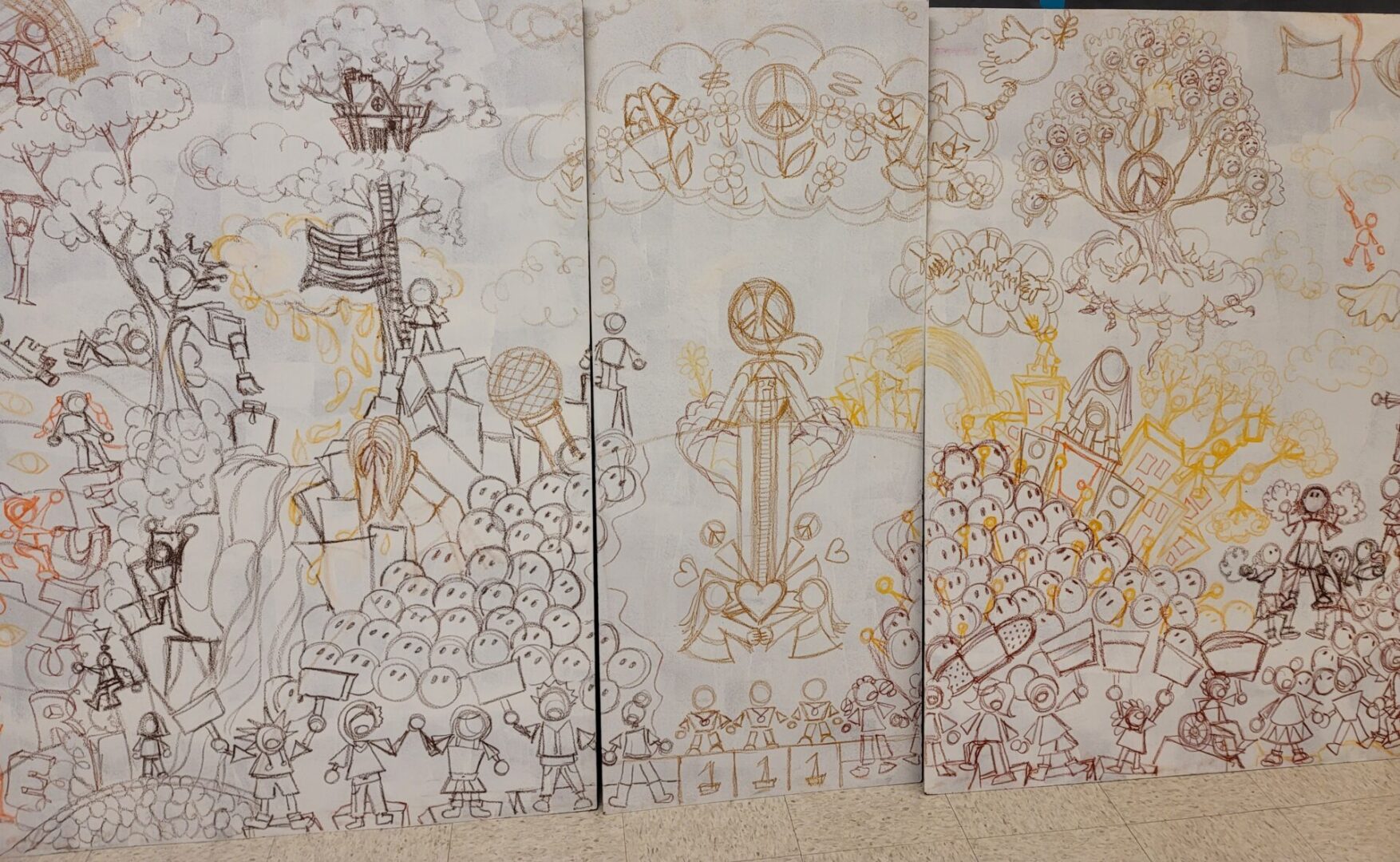
Essential Question: What is community art? After introducing myself, I introduced students to The Los Tres Grandes and the Mexican Muralist Movement. We discussed community art through the lens of Diego Rivera, David Siqueiros, and Jose Orozco. We talked about how illustrations are universal and how illustrators create mood. We looked at how “The Three Great Ones” encouraged, inspired, and educated their community by creating depth in space and depth in meaning. We took notes on how each artist connected to the past, present, and future through abstracted forms. We ended the first session brainstorming ideas for the mural’s theme: Globally Strong – Celebrating Diversity and Inclusion. The goal of this mural is to help students see themselves in the work and to spark curiosity and concern about the wider world outside of the Neelsville school community.
DAY 2: COMMUNICATION W/ PICTURES
Essential Question: How do illustrators use words and phrases to inspire visual images? This day is all about helping students find sources for their inspiration. I model this by sharing a list of inspirational and encouraging words. I originally played a slam poet’s performance through video but found that the students responded better to having text in their hands in addition to hearing audio. This is true arts integration. The list of words came to the rescue, but I need to get this slam poet’s poem in writing so that I can include it in the next residency. Students discuss peer to peer to see if they are clearly communicating with pictures or need to add more details for clarity. Students also practiced creating depth in sketches rather than listing thoughts and info through doodles. Students use the Severe Seven shapes as building blocks to draw objects after a short introduction to the possibilities they offer when drawing.
DAY 3: CREATING ICONS
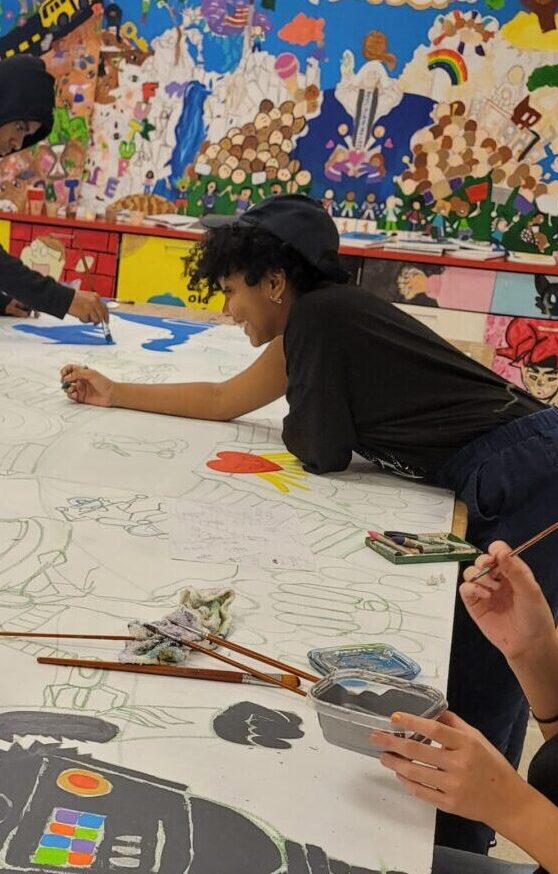
What is Iconography? It comes from two Greek words eikon (meaning “image”) and graphe (meaning “writing”) together we get “Image-writing”. The word “iconography” conveys the idea that an image can tell a story. Students learn the impact of Icons — compact visual symbols that exist to help communicate a message. Whether used for navigation and way-finding, for representing an idea, or for illustrating something, icons play an important role in communication and are relatable to this age group especially. Skibiki translated my worksheet into Spanish for ESL students. Students were prompted to brainstorm and sketch icons that represented their personality traits, values, hobbies, and heritage. It was in this session that I realized just how diverse the participating students were and all the things they had in common. Themes that were recurrent were needing more sleep, lots of responsibility, and love for family.
There were so many flags represented as icons that I have to figure out how to incorporate this into the mural somehow. I settled on creating end panels for each of the two mural sections, four in total. These end panels will be filled with all the flags that represent the students to flank the mural like tiled bricks illustrating the foundation of our work together. Students were excited to show their cultural pride. Some students struggled to come up with a full page of thumbnails that represented them but everyone made an attempt and ended up with at least a few icons that represented them. Some students needed more time to process and generate imagery. Some students comfortably started to pull up resource images on their laptops to inspire their sketches. We talked about how artists use resource images ethically. The students are learning the process of mural design and gathering understanding that I am collecting all their sketches and will select the sketches with the most clarity and depth in meaning to create the mural’s design.
They prefer to answer my questions through drawing rather than speaking in front of the crowd. Still, the side conversations I am having with students in private lets me know they have a lot to say. They just aren’t comfortable letting it all hang out in front of their classmates. A few brave souls fight confidence issues to share answers in front of the class with a little coaxing. I joked with them that I would have to just draw a bunch of crickets chirping in the mural without them. They are the natural born leaders emerging to the surface to help guide the process. Their art unknowingly is highlighted in the design because of their vulnerability and willingness to open themselves to the experience. They are the ones who are happy to share their views and opinions through art. Working with all the students no matter their level, so far has been a breath of fresh air. They are respectful and kind to me but need gentle reminders of how to be that way to each other and what it means to work together as a community. I’m happy to remind them. They giggle because they know I speak the truth. We practice lifting each other up instead of putting each other down, daily. Some students are trying harder than others, LOL.
DAY 4: CREATING COMPOSITION
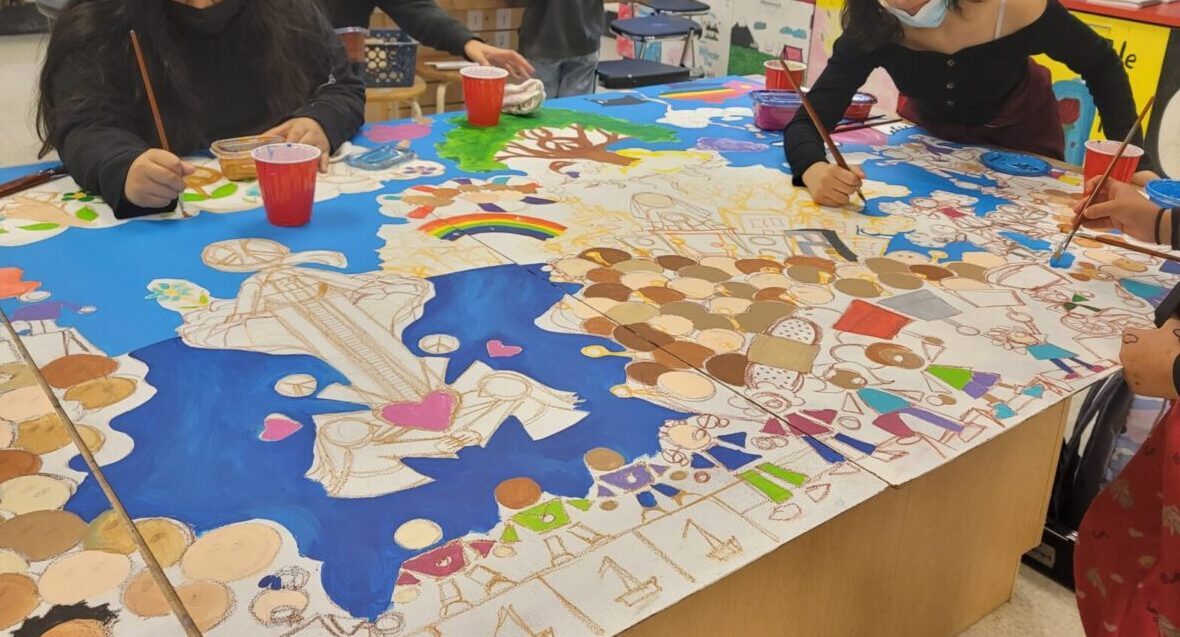
What pictures do you see when you hear Amanda Gorman’s inauguration poem, “The Hill We Climb”? I’ve been waiting to capture this poem in a mural since I heard it. I know the magic of introducing students to that kind of poem. I’ve illustrated Maya Angelou’s inauguration poem with students and it was a treat to behold upon completion. This process was no different and the perfect opportunity to capture the essence of “The Hill We Climb” with a group of students. I separated the poem into 25 pieces, put each piece into a shoebox and had students randomly select the line that would be assigned to them to illustrate. We discussed the nature of composition – “to put together” – with the use of line, shape, and color. We discussed how artists use the elements of art and principles of design to create interesting compositions. We discussed how artists use visual clues to communicate the words they are inspired by. Many students remembered hearing the poem live but it was the first time everyone in each class was taking a real look at the words outside of Gorman’s performance. The students worked to create depth in meaning and brainstormed how to illustrate their portion of the poem.
DAY 5: CREATING UNITY
Essential Question: How can a set of disparate, random ideas be unified? What can you do collaboratively to tie sketches, icons and personal narratives together to work as a cohesive group? Students work in groups to create vision boards for the mural or add one last sketch idea to the pile to send me off into the studio as the mural’s composer. Lots of prep needs to happen before the next session that will kick off the painting workshops. I have to take all of their drawings and figure out how to put them all together to create one picture. Mr. Skibiki pointed out that the design reminded him of Hieronymus Bosch’s “Garden of Earthly Delights”. I weaved the students’ sketches sequentially with the lines of “The Hill we Climb” and ended up with 14 total panels not including the four flag panels. The students gave me so much to work with, the whole weekend went by and I was still drawing. I finished 7 panels to start the painting workshops on the following Monday. The other 7 panels came later but each section was pretty awesome, I couldn’t wait to see the students’ reaction.
DAY 6-10: PAINTING WORKSHOPS
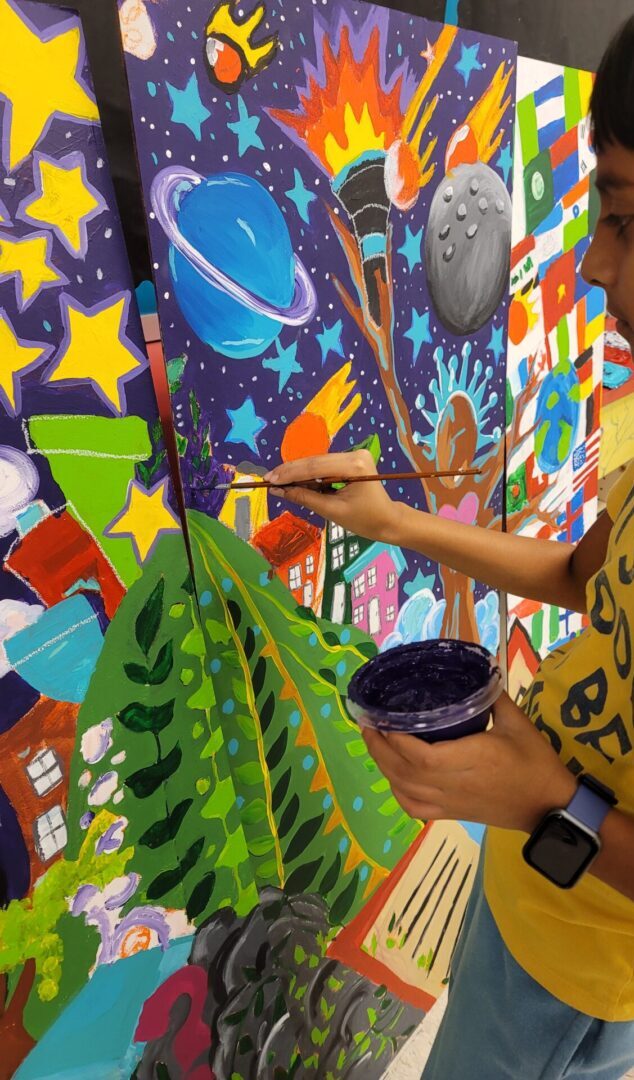
Start off with Ms. D’s painting rules because complete and utter madness ensues without them. We talk about the brush stroke, painting in thin layers with acrylic and how to clean the paint brush properly. We discuss brush size and how to make sure your brush is always having a good hair day. I introduce the system for keeping things organized and reinforce and clarify expectations during and at the start of every class after. Things can go awry with paint pretty quickly. Patience becomes a virtue and redirection is necessary with reminders about why these steps are important to this process. Some students take that redirection better than others. Some students struggle with their mistakes and being corrected, especially publicly. I have to find the balance of highlighting teachable moments for everyone and opt to instead of calling a student out, making global announcements that redirect their behaviors on the low. I explain myself when given the opportunity. Students adjust and work together to create an efficient and safe studio space. It takes some students longer than others to process and come around to the new community agreement. Reframing it as such the next time around will help soften the delivery next time. The 6th grade students are less confident and focused than the 7th and 8th graders. Students have to grasp that their artwork is no longer their individual artwork but now it belongs to everyone. Some students struggle with holding the brush and grasping the thin layering technique instead of clumping on translucent colors. They need lots of reminders about using the correct brush size but learn quickly that there’s a method to Mrs. D’s madness. Me and the students are often relieved to get a redo when the paint dries. They take the process all in stride and learn how to be more productive than counterproductive. They take pride in seeing their work come to life through painting. The panels welcome them daily into the space and the students have a sense of pride in being a part of the process.
Clean up goes more smoothly than expected although a few folks need to be scrubbed down at the sink from not adhering to the painting rules. It could have been worse, lol. Thankful for the spacious studio space and for Daniel’s support with classroom management. I didn’t get the reaction I was hoping for when they first saw the design. This age group is way too cool for school and pretty much refuse to show real emotion in front of their peers. I accepted their slight grins as consolation when they saw their work had been included and elevated now that it was part of the mural’s message. A few students managed to muster up a few upward inflections before gathering themselves to acknowledge their work. I kept praising their efforts despite their attempts to conceal their interests or happiness with the outcome.
I was surprised that most students chose to stay at their usual seats and let go of having to paint their own artwork. I think it’s because they were sitting with the people that made them feel most comfortable. Sometimes this was a distraction but students responded well to redirection and the reminders about how we treat and talk to each other as community members while making community art. This also reiterated all the messages that managed their way into the mural about peace, unity and inclusion.
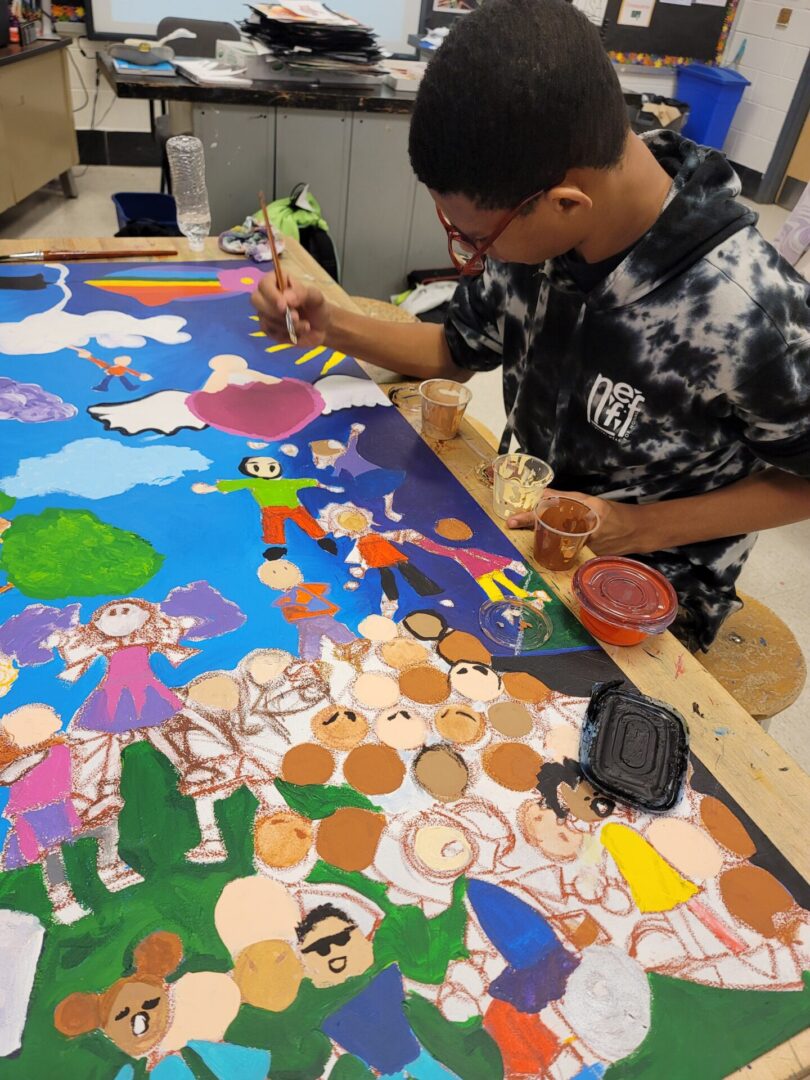 There is a table of students in one class that does not speak English well. Mr. Skibiki translates and assists when needed. There are a couple of students who have behavioral issues but are well behaved and respond well to clarifying expectations and guided instructions. A couple students had a hard time letting go of their artwork but we worked through those moments together. One student is hesitant to move forward because he doesn’t want to make a mistake. I reassure him that paint is forgiving until he believes me and chooses to work on small details.
There is a table of students in one class that does not speak English well. Mr. Skibiki translates and assists when needed. There are a couple of students who have behavioral issues but are well behaved and respond well to clarifying expectations and guided instructions. A couple students had a hard time letting go of their artwork but we worked through those moments together. One student is hesitant to move forward because he doesn’t want to make a mistake. I reassure him that paint is forgiving until he believes me and chooses to work on small details.
The biggest challenge is getting students to take their time, follow the steps laid out in the process, and work on a section until it’s done. Several don’t have the attention span to stick to one item and hop around from panel to panel, while others try to see what they’ve started through but get bored when there is no instant gratification. As the days progress they get to experience delayed gratification. There are a few students who feel the need to work on areas that don’t need it. I need to figure out how to clarify what is finished and what still needs more work.
Last Day of Painting:
All things considered, they did a great job of refining the work up to the final day of painting. This was the first time painting a mural for many students. They honored the work of Los Tres Grandes by using imagery to uplift, encourage, inspire and educate their school community. The mural also incorporates the past, present and the future to keep the Los Tres Grandes tradition. The viewer will always see something different through the artist’s clues embedded in the mural’s design. I will need to finish each panel to prepare it for installment but the majority of the work is done. I could have used a little more assistance throughout the process redirecting students and reinforcing techniques. Sometimes it felt like there wasn’t enough of me to go around in the larger class sizes but we made it work. I am pleased with the outcome and inspired by the process. This mural residency is a great introduction for students to the power of community art.
I’m looking forward to seeing the mural hanging over the library’s entrance. We are prepping for an unveiling on November 30th at Family Night. Lots of work to do but I’m closer to the finish line and had a wonderful experience with Mr. Skibiki and his students. I built relationships and rapport with students and look forward to supporting the other artists the remainder of the school year.
contributed by Danyett Tucker, Teaching Artist and Innovation and Partnerships Director
Ready to learn more about Story Tapestries programs? Explore programs now!
Better yet – fill out a short form to tell us about your programming dreams and Book a program!

